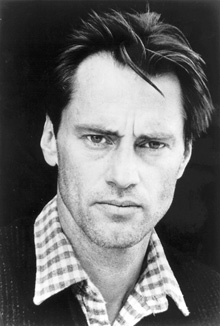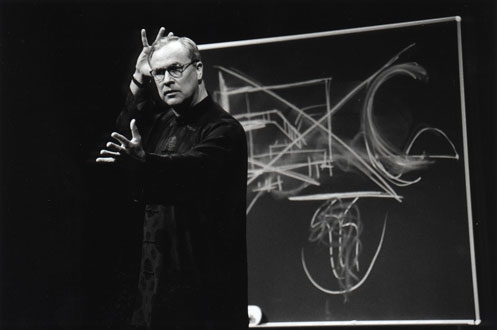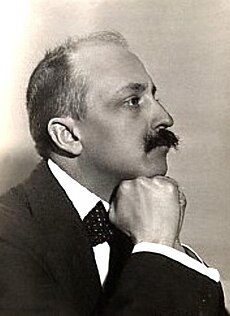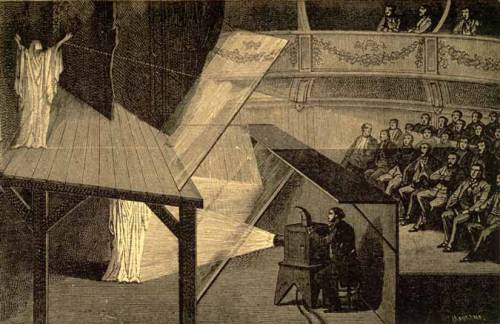This final unit of theatre history catches us up to present day. More theatrical experimentation led to new and various production experiences. The changing society led to new accomplishments and strides from various emerging communities such as African-American theatre and women’s theatre. New voices led to the theatrical landscape becoming its own melting pot of human experiences. New forms of theatre provoked social change from ordinary people, such as The Open Theatre in the midst of New York City’s Times Square. Even today, contemporary theatre is exciting because of these advances by people- their input creating stimulating new works and experiences.
Wednesday, May 1, 2013
4/30/13- Female Playwrights
-any non-conflict models that can be used effectively for play structures?
Gertrude Stein, 1874-1946
-stream-of-consciousness writing style
-"The Mother of Us All" (libretto of 1946 opera)
Susan Glaspall, 1876-1948
-"Trifles", 1916
-won Pulitzer Prize
-worked with Federal Theatre Project
-Provincetown Players with Eugene O'Neill
Sophie Treadwell, 1885-1970
-Machinal, 1928 (The Life Machine in London premiere)
Clare Booth Luce, 1903-1987
-congresswoman, ambassador, & playwright
-1936, The Women
Lillian Hellman, 1905-1984
-The Children's Hour
-The Little Foxes
-blacklisted by Hollywood during the McCarthy era
Alice Childress, 1920-1994
-first black woman to produce her play AND direct it
-Trouble in Mind
Lorraine Hansberry, 1930-1965
-A Raisin in the Sun
-first Broadway-produced play written by a woman
Maria Irene Fornes (1930- )
-Mud, 1983
-Fefu & Her Friends, 1977 (rotate around rooms!)
-won 9 Obies (Obie = covers off-Broadway awards)
-mentor of Nilo Cruz
-immigrated from Cuba when she was just 15 years old
Adrienne Kennedy
-Funnyhouse of a Negro
-surrealist writing style
Megan Terry (1932- )
-Viet Rock, 1962
Tina Howe
-Coastal Disturbances
-Tony-nominated, 2-time Pulitzer nominee
Caryl Churchill
-Cloud Nine, 1979
-most famous Feminist playwright of 20th Century
-Vinegar Tom
-influenced by Brecht & Artaud
Marsha Norman, 1947-
-'night, Mother (1983)
-Getting Out, 1977
-Pulitzer winner
-wrote libretti for numerous Broadway musicals
(The Color Purple & The Secret Garden)
Ntozake Shange (1948- )
-For Colored Girls..... , 1975
-Obie winner
-Guggenheim fellow
Wendy Wasserstein, 1950-2006
-Tony & Pulitzer winner
-Guggenheim fellow
-Heidi Chronicles, 1988
Anna Deavere Smith, 1950-
-one woman shows
-Tony & Pulitzer-nominated
-known for many TV & film roles
-Fires in the Mirror, 1992
Paula Vogel
-How I Learned to Drive, 1997
-Pulitzer winner
-KCACTF Award named after her
-The Baltimore Waltz
-Brechtian devices (i.e. Chorus) to prevent audiences from getting too freaked out by subject matters
Beth Henley, 1952-
-Abundance
-Crimes of the Heart
-grad of SMU in Dallas
-Pulitzer winner
-Magic Realism or Realism
Theresa Rebeck, 1959-
-Omnium Gatherum, 2003 (visually difficult, but great play- like No Exit)
-MFA and PhD
-worked on NYPD Blue, Law & Order, & Smash
Yasmina Reza, 1959-
-Art, 1994
-God of Carnage, 2006
-French playwright
-International award-winner
Suzan-Lori Parks
-Topdog/Underdog
-MacArthur Award
-Pulitzer winner
Lynn Nottage, 1964-
-Ruined, 2008
-Intimate Apparel, 2003
-plays deal with issues in Africa
Rebecca Gilman, 1964-
-The Glory of Living
-really no catharsis in this piece
-Boy Gets Girl
-hard subject matters
Regina Taylor
-Crowns
-first black woman to play Juliet on Broadway
Julia Jordan, 1968-
-Tatjana in Color, 2004
-writes for As the World Turns
Sarah Ruhl, 1974-
-Eurydice
-Dead Man's Cell Phone
-In the Next Room
-MacArthur fellow & Pulitzer winner
~~~~~~~~~~~~~~~~~~~~~~~~~~~~~~~~~~~~~~~~~~~~~~~~~~~~~~~~~~~~~~~~~~~~
Gertrude Stein, 1874-1946
-stream-of-consciousness writing style
-"The Mother of Us All" (libretto of 1946 opera)
Susan Glaspall, 1876-1948
-"Trifles", 1916
-won Pulitzer Prize
-worked with Federal Theatre Project
-Provincetown Players with Eugene O'Neill
Sophie Treadwell, 1885-1970
-Machinal, 1928 (The Life Machine in London premiere)
Clare Booth Luce, 1903-1987
-congresswoman, ambassador, & playwright
-1936, The Women
Lillian Hellman, 1905-1984
-The Children's Hour
-The Little Foxes
-blacklisted by Hollywood during the McCarthy era
Alice Childress, 1920-1994
-first black woman to produce her play AND direct it
-Trouble in Mind
Lorraine Hansberry, 1930-1965
-A Raisin in the Sun
-first Broadway-produced play written by a woman
Maria Irene Fornes (1930- )
-Mud, 1983
-Fefu & Her Friends, 1977 (rotate around rooms!)
-won 9 Obies (Obie = covers off-Broadway awards)
-mentor of Nilo Cruz
-immigrated from Cuba when she was just 15 years old
Adrienne Kennedy
-Funnyhouse of a Negro
-surrealist writing style
Megan Terry (1932- )
-Viet Rock, 1962
Tina Howe
-Coastal Disturbances
-Tony-nominated, 2-time Pulitzer nominee
Caryl Churchill
-Cloud Nine, 1979
-most famous Feminist playwright of 20th Century
-Vinegar Tom
-influenced by Brecht & Artaud
Marsha Norman, 1947-
-'night, Mother (1983)
-Getting Out, 1977
-Pulitzer winner
-wrote libretti for numerous Broadway musicals
(The Color Purple & The Secret Garden)
Ntozake Shange (1948- )
-For Colored Girls..... , 1975
-Obie winner
-Guggenheim fellow
Wendy Wasserstein, 1950-2006
-Tony & Pulitzer winner
-Guggenheim fellow
-Heidi Chronicles, 1988
Anna Deavere Smith, 1950-
-one woman shows
-Tony & Pulitzer-nominated
-known for many TV & film roles
-Fires in the Mirror, 1992
Paula Vogel
-How I Learned to Drive, 1997
-Pulitzer winner
-KCACTF Award named after her
-The Baltimore Waltz
-Brechtian devices (i.e. Chorus) to prevent audiences from getting too freaked out by subject matters
Beth Henley, 1952-
-Abundance
-Crimes of the Heart
-grad of SMU in Dallas
-Pulitzer winner
-Magic Realism or Realism
Theresa Rebeck, 1959-
-Omnium Gatherum, 2003 (visually difficult, but great play- like No Exit)
-MFA and PhD
-worked on NYPD Blue, Law & Order, & Smash
 |
| Omnium Gatherum |
Yasmina Reza, 1959-
-Art, 1994
-God of Carnage, 2006
-French playwright
-International award-winner
Suzan-Lori Parks
-Topdog/Underdog
-MacArthur Award
-Pulitzer winner
Lynn Nottage, 1964-
-Ruined, 2008
-Intimate Apparel, 2003
-plays deal with issues in Africa
Rebecca Gilman, 1964-
-The Glory of Living
-really no catharsis in this piece
-Boy Gets Girl
-hard subject matters
Regina Taylor
-Crowns
-first black woman to play Juliet on Broadway
Julia Jordan, 1968-
-Tatjana in Color, 2004
-writes for As the World Turns
Sarah Ruhl, 1974-
-Eurydice
-Dead Man's Cell Phone
-In the Next Room
-MacArthur fellow & Pulitzer winner
 |
| Dead Man's Cell Phone |
Like African-Americans, women have made huge strides in their theatrical accomplishments. Lillian Hellman was a brilliant playwright, having written two of my favorite plays: The Children’s Hour and The Little Foxes. Unfortunately she was blacklisted by Hollywood during the McCarthy era. Anna Deavere Smith is a brilliant playwright and actress. She performs dozens of characters in her one-woman shows that deal with very serious topics in places where something catastrophic has recently occurred. Yasmina Reza and Sarah Ruhl are two of the best & biggest modern female playwrights. They have both already produces multiple hit plays that are currently influencing the landscape of contemporary theatre.
4/25/13- Hispanic Theatre
3 Primary Forms since 1970
-Puerto Rican/Nuyorican (/Dominican)
-Chicano/Mexican
-Cuban
Chicano/Mex-American
-El Teatro Campesino (farm workers' theatre)
-cultural arm of United Farm Workers (enacted events inspired by lives of audience)
Luis Valdez- Zoot Suit
Gente de Teatro (based in Houston!)
Cuban-American Writers
-Maria Irene Fornes (Fefu & Her Friends.... perception)
-Manuel Martin
-Ivan Acosta
-Nilo Cruz
-Mario Pena
-Dolores Prida
-Omar Torres
Miguel Pinero
-cofounder of Nuyorican Poets Cafe
-"Short Eyes"
Jose Rivera
-first Puerto Rican playwright/screenwriter to be Oscar-nominated
Asian-American Theatre
-David Henry Hwang---- M. Butterfly
-Puerto Rican/Nuyorican (/Dominican)
-Chicano/Mexican
-Cuban
Chicano/Mex-American
-El Teatro Campesino (farm workers' theatre)
-cultural arm of United Farm Workers (enacted events inspired by lives of audience)
Luis Valdez- Zoot Suit
Gente de Teatro (based in Houston!)
Cuban-American Writers
-Maria Irene Fornes (Fefu & Her Friends.... perception)
-Manuel Martin
-Ivan Acosta
-Nilo Cruz
-Mario Pena
-Dolores Prida
-Omar Torres
Miguel Pinero
-cofounder of Nuyorican Poets Cafe
-"Short Eyes"
Jose Rivera
-first Puerto Rican playwright/screenwriter to be Oscar-nominated
Asian-American Theatre
-David Henry Hwang---- M. Butterfly
Tuesday, April 30, 2013
4/23/13- African-American Theatre
What constitutes it?
-writer? story? characters? actors? audience? producing theatre?
Samuel Hay's Two General Directions
1. The Black Experience
-writer? story? characters? actors? audience? producing theatre?
Samuel Hay's Two General Directions
1. The Black Experience
- characters off the streets, out of joints and drives
- themes directed towards African-Americans
- language of ordinary folks dressed up with poetry, music & dance
2. The Black Arts (like Tyler Perry)
- characters as model humans & historical figures
- themes notices and understood by white people
African Grove Theatre, 1821
-James Hewlitt
William Wells Brown
-first play published by an African-American, this comic 1858 melodrama depicted 2 types of African-Americans: cliche and respectable, put together
Ira Aldridge, "The African Roscius" (Roscius = Thespian)
(Minstrel shows- both races)
The Black Vaudeville song and dance team
-Bert Williams and George Walker ("In Dahomey")
Eubie Blake, 1883-1983
-ragtime and musicals
"Shuffle Along"
Charles Sydney Gilpin & Paul Robeson as "Emperor Jones"
-I want a Black actor to play this Black role (even though Broadway was also segregated)
Harlem Renaissance (1920s thru early 1930s)
-a celebration of creativity
-Langston Hughes (1902-1967)
-Negritude- we're doing our things, our way
Porgy & Bess, 1935
-written for black by whites (Gershwin)
Voodoo Macbeth, 1935
-The USA Work Program created jobs for people (Group: The Negro Unit)
-directed by Orson Welles
-took the Scottish Play and set it in Haiti for supernatural awareness
"Swing Mikado" and "Hot Mikado"- versions of Rodgers & Hammerstein shows
Carmen Jones
-first Rodgers & Hammerstein show written for an all-black cast
Negro Repertory Company
-Androcles
-Lysistrata
DC: Howard Theatre
1943- Robeson was first time a black actor played Othello, opposite Uta Hagen as Desdemona
American Negro Theatre (1940-1944)
-biggest alum: Harry Bellafonte
Black Arts Movement (mid60s- mid70s)
"the artistic sister of the Black Power Movement"
Afro-Centricity- shift from Negro/black to African-American heritage
New Lafayette Theatre (1968-early 70s)
-to give whites a view
LeRoi James/Amiri Baraka (1935- )
-Dutchman, 1964
-modeled like Ionesco's "The Lesson"
Lorraine Hansbery
-first African-American to have show on Broadway
-"A Raisin in the Sun"
Ensemble Theatre in Houston, Texas!!
Ntozake Shange
-"For Colored Girls..."
-writes "choreopoems"- poetry to be staged with wonderful movement
Adrienne Kennedy
-"Sleep Deprivation Chamber"
-best known: "Funnyhouse of a Negro"
Suzan-Lori Parks
-Venus
-365 Days/365 Plays
-In the Blood
-Topdog/Underdog (Pulitzer Prize-winning play of 2002)
August Wilson (1945-2005)
-wrote a play for each decade, to give insight into African-American history with each family
"Fences"
George Wolfe
-The Colored Museum
-dark comedy dealing with biting issues
~~~~~~~~~~~~~~~~~~~~~~~~~~~~~~~~~~~~~~~~~~~~~~~~~~~~~~~~~~~~~~~
~~~~~~~~~~~~~~~~~~~~~~~~~~~~~~~~~~~~~~~~~~~~~~~~~~~~~~~~~~~~~~~
African-Americans have made huge strides in their own theatre culture in America; they have come a long way from the Minstrel shows of long ago. I particularly enjoy the Voodoo Macbeth production, which was directed by Orson Welles for Broadway. Suzan-Lori Parks’ Topdog/Underdog, a Pulitzer Prize-winning play, is a perfect example of how far African-Americans have come. One of the biggest African-American playwrights in the last century was August Wilson. His play, Fences, stands as one of the most widely-known African-American plays. I love that Wilson captures history with every play that he has written.
4/18/13- Svoboda & Grotowski
Josef Svoboda
most important person in 21st Century theatre technology & design
considered himself a "scenographer"
Laterna Magika
Black Theatre Prague- Black Light Performance
Prague Quadrennial- Theatre Design Olympics
Lee Breur (with group Maboo Minds)
what makes theatre work or not work?
Red Horse Animation
animations are semi or autobiographical
experimented with Bunraku-style puppets
The Gospel at Colonus- embellishing the Chorus part of Oedipus
Jerry Grotowski
1933-1999
Book of Articles: "Towards a Poor Theatre"
"we can't compete with film, so why do we try?"
get theatre back to most organic thing it can be: just the audience, actors, creativity & imagination
Most Famous: "The Constant Prince"
"Poor Theatre"- artists get rid of tools; use your own body/voice to create visual moments and experiences
"Akropolis"- Quality of Movement
most important person in 21st Century theatre technology & design
considered himself a "scenographer"
Laterna Magika
Black Theatre Prague- Black Light Performance
Prague Quadrennial- Theatre Design Olympics
 |
| Svoboda's design work ScenEGOgraphy: The Stage Designer as Author |
 |
| Svoboda |
Lee Breur (with group Maboo Minds)
what makes theatre work or not work?
Red Horse Animation
animations are semi or autobiographical
experimented with Bunraku-style puppets
The Gospel at Colonus- embellishing the Chorus part of Oedipus
Jerry Grotowski
1933-1999
Book of Articles: "Towards a Poor Theatre"
"we can't compete with film, so why do we try?"
get theatre back to most organic thing it can be: just the audience, actors, creativity & imagination
Most Famous: "The Constant Prince"
"Poor Theatre"- artists get rid of tools; use your own body/voice to create visual moments and experiences
"Akropolis"- Quality of Movement
4/16/13- The Open Theatre
The Open Theatre 1963-1973
Founder: Joseph Chaikin (1935-2003)
auteur- "director is god"
collaborator- shepherd guiding the process
Chaikin believed in a Wheel, not a Pyramid hierarchy
Famous for "The Serpent", 1967
Very politically-conscious
"The Terminal" (another outline scenario)
Jean-Claude van Itallie
"America Hurrah!"
-The Interview (great show; Part 1)
-TV
-Motel
La Mama (Gray Shapeless Monster)--- Experimental Theatre
Joe Chaikin & Sam Shepard, 1984
-Shepard was the "it" playwright in 80s/90s
-Chaikin had a stroke, so Shepard stepped in
"Tongues", 1972
Shepard- Magic Realism
Founder: Joseph Chaikin (1935-2003)
auteur- "director is god"
collaborator- shepherd guiding the process
Chaikin believed in a Wheel, not a Pyramid hierarchy
Famous for "The Serpent", 1967
Very politically-conscious
"The Terminal" (another outline scenario)
 |
| Chaikin |
Jean-Claude van Itallie
"America Hurrah!"
-The Interview (great show; Part 1)
-TV
-Motel
La Mama (Gray Shapeless Monster)--- Experimental Theatre
Joe Chaikin & Sam Shepard, 1984
-Shepard was the "it" playwright in 80s/90s
-Chaikin had a stroke, so Shepard stepped in
"Tongues", 1972
Shepard- Magic Realism
- like Labyrinth or Pan's Labyrinth
- includes overly violent movies like Machete or Django Unchained
Shepard's "Buried Child"
Bread and Puppet- indoor & outdoor theatre
-humongous puppets
-feed audiences (break bread together)
Richard Schechner
-radical stagings of classical material
-Dionysus in '69
-Yokastas Redux, 2005
-explorer of environmental theatre
1968- Britain disbanded censorship
-first time since 1574 (that makes it 394 years!)
The WOOSTER GROUP
-"Chronology"
-Deconstructive Theatre
-Route 1 & 9- a deconstructed Our Town
Founding Member: Willem Dafoe
4/11/13- The 60's & 70's in Theatre
Pulitzer Prize Winners: Modern Masters of Drama
(O'Neill, Williams & Miller)
Alan Kaprow's "18 Happenings in Six Parts" (1959)
-experimental theatre!
-we can do theatre anywhere
Words, 1961
(sometimes called "happenings")
(Even haunted houses are meta-theatrical activities)
The Living Theatre
founded by: Julian Beck & Judith Malina
"The Strike Support Oratorium", NYC 1974
agit-prop (agitational propaganda = protests)
Tableaux- very dramatic still picture (even curtain calls count)
Chaikin and Gary Goodrow in The Connection, 1960
Frankenstein, 1975
The Living Theatre's Seven Imperatives
1. In the Street: outside of the cultural and economic limitations of institutionalized theatre.
2. Free: Performance for the proletariat, the Lumpenproletariat, the poor, the poorest of the poor, without admission charge.
3. Open Participation: Break thru, Unification: Collective Creation.
4. Spontaneous Creation: Improvisation: Freedom.
5. Physical life: Body: Sexual Liberation.
6. Change: Increase of Conscious Awareness: Permanent Revolution: Unfixed (Flexible, Free) Ideology.
7. Acting as Action.
(O'Neill, Williams & Miller)
Alan Kaprow's "18 Happenings in Six Parts" (1959)
-experimental theatre!
-we can do theatre anywhere
Words, 1961
(sometimes called "happenings")
(Even haunted houses are meta-theatrical activities)
The Living Theatre
founded by: Julian Beck & Judith Malina
"The Strike Support Oratorium", NYC 1974
agit-prop (agitational propaganda = protests)
Tableaux- very dramatic still picture (even curtain calls count)
Chaikin and Gary Goodrow in The Connection, 1960
Frankenstein, 1975
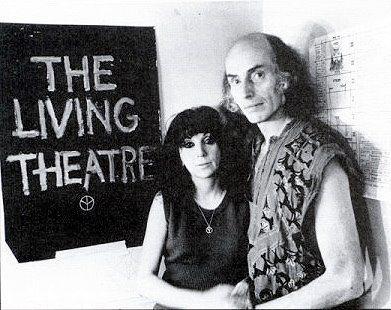 |
| Malina & Beck |
The Living Theatre's Seven Imperatives
1. In the Street: outside of the cultural and economic limitations of institutionalized theatre.
2. Free: Performance for the proletariat, the Lumpenproletariat, the poor, the poorest of the poor, without admission charge.
3. Open Participation: Break thru, Unification: Collective Creation.
4. Spontaneous Creation: Improvisation: Freedom.
5. Physical life: Body: Sexual Liberation.
6. Change: Increase of Conscious Awareness: Permanent Revolution: Unfixed (Flexible, Free) Ideology.
7. Acting as Action.
4/4/13- Epic Theatre & Bertolt Brecht
EPIC THEATRE
(opposite of Vaughner)
(intentional theatricalism)
(Most important person in 20th Century Theatre: Bertolt Brecht)
Erwin Piscator (German Theatre)
-Schiller's "The Robbers" (1957 design)
-design for "Hoppla, Such is Life!" in 1927 (poles & platforms, projection surfaces)
-Piscator's Regiebuch
-obsessed with projections (schema for projections: "K2")
BERTOLT BRECHT
Brecht and Kurt Weill
Paul Dessau
verfremdungsprinzip
verfremdungs effect- critical distancing rather than "alienation" of audience
epic theatre- rather than "dramatic" (Aristotelian)
didactic theatre- to teach, propagandize, incite to action
proletariat theatre- for the common person/the worker
Marxist- economic reasons for humanities' maladies
Antiscenery- visually provocative way of undoing traditional theatre set
DRAMATIC FORM
active
involves spectator in stage action
consumes his capacity to act
allows him to have feelings
spectator drawn into something
spectator experiences w/characters
one scene exists for another
suspense in awaiting outcome
EPIC FORM
narrative
spectator as observer
awakens his capacity to act
demands decisions from him
spectator confronted with something
spectator confronts/studies what he sees
each scene for itself
suspense at the process
"Critical Distance" created by....
(opposite of Vaughner)
(intentional theatricalism)
(Most important person in 20th Century Theatre: Bertolt Brecht)
Erwin Piscator (German Theatre)
-Schiller's "The Robbers" (1957 design)
-design for "Hoppla, Such is Life!" in 1927 (poles & platforms, projection surfaces)
-Piscator's Regiebuch
-obsessed with projections (schema for projections: "K2")
BERTOLT BRECHT
Brecht and Kurt Weill
Paul Dessau
verfremdungsprinzip
verfremdungs effect- critical distancing rather than "alienation" of audience
epic theatre- rather than "dramatic" (Aristotelian)
didactic theatre- to teach, propagandize, incite to action
proletariat theatre- for the common person/the worker
Marxist- economic reasons for humanities' maladies
Antiscenery- visually provocative way of undoing traditional theatre set
 |
| Brecht |
DRAMATIC FORM
active
involves spectator in stage action
consumes his capacity to act
allows him to have feelings
spectator drawn into something
spectator experiences w/characters
one scene exists for another
suspense in awaiting outcome
EPIC FORM
narrative
spectator as observer
awakens his capacity to act
demands decisions from him
spectator confronted with something
spectator confronts/studies what he sees
each scene for itself
suspense at the process
"Critical Distance" created by....
- theatricalism- always aware you're in the theatre
- expose lights/technical workings; don't use curtain
- actors "become" characters; stage crew visible
- self-referencing/direct address to audience
- "In this scene I play a soldier who is caught ....."
- includes songs and entertainment that break the action
- like commercials in movies on TV or during TV shows
- historification
- displace time or place to be unfamiliar to the audience
- use different races/ethnicities
- Man Equals Man: British soldiers in India c1900
- Good Person of Setzuan in China
- Galileo
- like a parable
"Mother Courage"
Robert Wilson's 2000 production with the Berliner Ensemble
Brechtian Design- set/design is more of a collage or montage or pastiche
~~~~~~~~~~~~~~~~~~~~~~~~~~~~~~~~~~~~~~~~~~~~~~~~~~~~~~~~~~~~~~~
~~~~~~~~~~~~~~~~~~~~~~~~~~~~~~~~~~~~~~~~~~~~~~~~~~~~~~~~~~~~~~~
Bertolt Brecht really changed the view of theatre. His insight into critically distancing the audience during performances for an entirely new theatrical experience was innovative and groundbreaking. His play The Threepenny Opera is still one of the most widely-produced plays of all time, all over the world. Elsewhere, one Robert Wilson is one of the most proficient American directors working in European theatre. He loves using Brechtian design devices in his productions. I saw one video of his version of Cabaret, in which he purposefully distances the audience from the performers, and it works seamlessly with the show Cabaret.
4/2/13- Existentialism & Absurdism
Existentialism
Sartre & Camus
def: the individual condemned to freedom
looks like normal play, but with profound philosophical point
Jean Paul Sartre
-No Exit
-The Flies (off-Broadway); Greek myth of Orestes
Albert Camus
-Myth Sisyphus: push boulder up hill for eternity
~~~~~~~~~~~~~~~~~~~~~~~~~~~~~~~~~~~~
Absurdism
Genet, Ionesco, & Beckett
-the meaningfulness of meaninglessness
-"I did everything I was supposed to / I played the game..... so what?"
-written starting after World War II
Jean Genet (great play: The Dayroom)
-to be moral, you must be immoral
-believed you must be amoral
-The Balcony- people wear costumes and you give them authority
-The Blacks
-The Maids- 2 women decide to murder the mistress of the house
Eugene Ionesco (fun plays)
-The Bald Soprano
-Amedee
-Rhinoceros- wouldn't life be easier if you just conform?
-The Chairs
Absurdists: There is no such thing as 'truth'
-all meaning ascribed/created
-if you had grown up free from other humans, what would you believe?
Ionesco- LOGIC itself is a construct
Sartre & Camus
def: the individual condemned to freedom
looks like normal play, but with profound philosophical point
Jean Paul Sartre
-No Exit
-The Flies (off-Broadway); Greek myth of Orestes
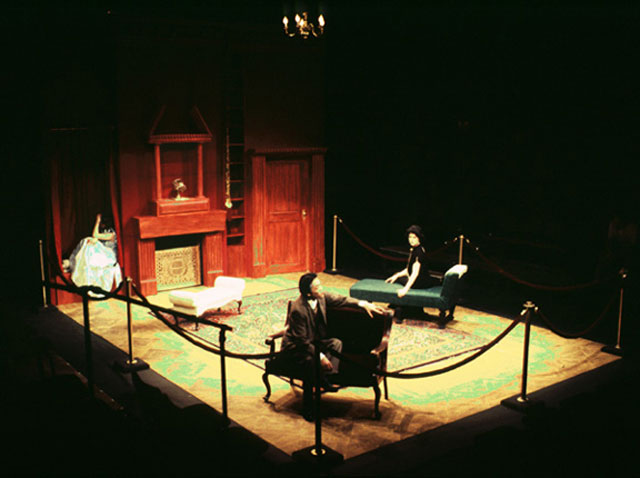 |
| No Exit |
Albert Camus
-Myth Sisyphus: push boulder up hill for eternity
~~~~~~~~~~~~~~~~~~~~~~~~~~~~~~~~~~~~
Absurdism
Genet, Ionesco, & Beckett
-the meaningfulness of meaninglessness
-"I did everything I was supposed to / I played the game..... so what?"
-written starting after World War II
Jean Genet (great play: The Dayroom)
-to be moral, you must be immoral
-believed you must be amoral
-The Balcony- people wear costumes and you give them authority
-The Blacks
-The Maids- 2 women decide to murder the mistress of the house
Eugene Ionesco (fun plays)
-The Bald Soprano
-Amedee
-Rhinoceros- wouldn't life be easier if you just conform?
-The Chairs
 |
| Ionesco's "The Chairs" |
Absurdists: There is no such thing as 'truth'
-all meaning ascribed/created
-if you had grown up free from other humans, what would you believe?
Ionesco- LOGIC itself is a construct
~~~~~~~~~~~~~~~~~~~~~~~~~~~~~~~~~~~~~~~~~~~~~~~~~~~~~~~~~~
Existentialism and Absurdism are two very important movements in the history of theatre. This semester I directed a scene from Jean-Paul Sartre’s No Exit and hope to direct this great piece for Summer Repertory Theatre. Plays written like Albert Camus’ Myth Sisyphus are a fascinating departure from expected Realism- adding on a component of philosophy. Absurdism completely breaks down meaning and logic in plays, sometimes completely segueing into utter gibberish to make its own point. I just read Jean Genet’s The Dayroom, and think it would make a really great play to direct some day.
Monday, April 1, 2013
Unit 2- Final Thoughts
This unit dealt with a whole lot of “Ism’s” that sprang up in the history of theatre. The style of theatre began with Realism and subsequently swung through a plethora of explorative new ideas and options for people to express themselves and their time periods through.
From a design standpoint, the departure from Realism really gave birth to a whole new spectrum of opportunities to explore in the realm of theatre. No longer would thespians be forced to depict life realistically (sometimes to a fault)- they could use motifs or symbolism to add new and deeper layers of meaning. In a way, Realism began to constrict the imaginations of designers, and still to this day is capable of doing this. Realism is well and good in some instances; in others, we should always strive to find whatever design concept would bring new life into the theatre (be it expressionism, surrealism, dadaism, etc.).
I, personally, find the concept of Expressionism to be of particular interest. I think its uses are near limitless- in fact I think I could easily say that Expressionism seems to me like it could almost be used in nearly any play to some extent. Within reason, there doesn’t seem to be any genre hat Expressionism could assist and strengthen. By comparison, Dadaism seems to be limited to me- with very few points that it can make (regardless of the limitless ways it can achieve them). Meanwhile Expressionism cannot help but unburden the design team. Realism dictates that every brick and blade of grass must abide to how life truly is. Set, in particular, can therefore prove taxing and time-consuming. This is especially true when compared to the conceptual freedom found in Expressionism; a set of a family’s house does not necessarily need walls or a roof. The audience can buy into such creative choices, and in fact relishes them. The human brain recognizes the unusualness of the situation and inherently appreciates this derivation from normalcy. I have not personally designed many sets but I feel like this route gives so many more options to staging a production.
I enjoyed the involvement of so many famous painters in each movement. It was a great reminder that these various movements did not simply involve the theatre world as it affected society- it affected painters and musicians, poets and dancers. Even the great Pablo Picasso collaborated with thespians and dabbled in designing shows.
Without the exploration of new possibilities, theatre would simply grow stagnant and stale. We would be performing shows virtually the same as when they were mounted in William Shakespeare’s days. Even today, shows are constantly exposing people to new and more experimental forms of theatre. With every passing decade, theatre evolves even more. It may feel like not much is changing, but change is always being sought after. We cannot feel the Earth moving as it rotates and revolves around the Sun, and yet we know that it is constantly moving- always shifting. Theatre can not stand still either or else it will wither and die. Without continual experimentation or exposure to new ideas, any category or subject would become fossilized. I’m proud to live in a time when we can look to any of these movements for inspiration, as well as many contemporary techniques for execution. Combining any number of these practices will always lead to a new and unrealized form of theatre. I suppose all of these creative movements help theatre to always remain pertinent to wherever society is at the time. In some cultures it may not always be accepted, but as we have seen in history it is also embraced and celebrated! Such is the impact of man’s imagination- the theatre, and what he can make with it, are limited only to what he can dream up.
3/28/13- Antonin Artaud
ANTONIN ARTAUD
- started with surrealists and was too crazy/outrageous for them!
- associated with the Theatre of Cruelty (EX. A Clockwork Orange- aversion therapy)
4 Levels of Appeal
- Emotional (most common)
- Intellectual
- Visceral (connection to the animal urges)
- Metaphysical (Spiritual/Transcendent)
Visceral- like Baywatch or Psycho (physically attractive or repulsive)
Theatre of Cruelty's purpose: catharsis (just like Aristotle)
Artaud: if you can experience this vicariously then it acts as aversion therapy for audience members
- doesn't work for vengeance- anything that would only perpetuate violence doesn't count
 |
Artaud
- French actor in silent films; leading man
- severe mental illness- eventually institutionalized
- "The Theatre and Its Double"- collection of his essays
- (Harold Pinter's "One for the Road")
- "The Theatre has been created to drain abscesses collectively"--- VERY famous phrase
- Wrote: "I Cenci" and "The Spurt of Blood"
3/26/13- Expressionism & Surrealism
(illusionary technique- "Pepper's Ghost")
EXPRESSIONISM
-artistic style, artist depicts the subjective emotions and responses that objects & events arise in him
-through: distortion, exaggeration, primitivism, and fantasy
EXPRESSIONISM
-artistic style, artist depicts the subjective emotions and responses that objects & events arise in him
-through: distortion, exaggeration, primitivism, and fantasy
- Edvard Munch: The Scream, 1893 (Norwegian expressionistic painting)
- Oskar Kokoschka
- Munch's The Sick Child, 1907
- George Rovalt's The Slaughter, 1907
- Otto Dix, The Journalist Sylvia Von Harden, 1926
- George Grosz's "The Convict", 1920
- Grosz- influenced by Dada
- The Hairy Ape by Eugene O'Neill
- O'Neill- Father of American Realism
- America's premier playwright
- Expressionistic works are exciting
- Comics are applied Expressionism
- Elmer Rice's The Adding Machine
- Philosophical Component of Expression; it's the Antithesis of Futurism
- Nostferatu (Germany, 1922)
- Tim Burton- most famous contemporary Comic Expressionist
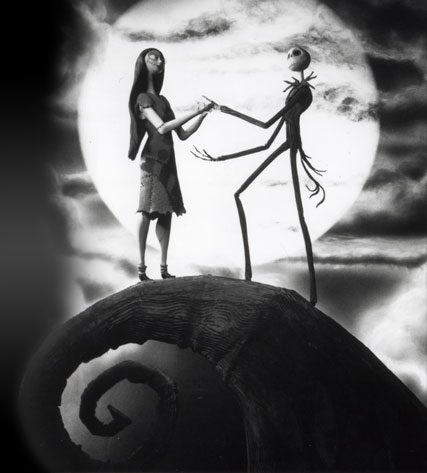 |
| The Nightmare Before Christmas. You can thank Tim Burton. |
- "Machinal" by Sophie Treadwell
- "The Cabinet of Dr. Caligari"
- "Metropolis"- 1927
- "Dark City"- 1998
- (Secret Door via Tumblr)
~~~~~~~~~~~~~~~~~~~~~~~~~~~~~~~~~~
SURREALISM
(dreamstate)
(video: Doll Face)
- Hieronymous Bosch (c. 1450-1516)- "Garden of Earthly Delights"
- 20th Century literary and artistic movement
- attempts to express workings of the subconscious by fantastic imagery and incongruous juxtaposition of subject matter
- Flourished between World War I and World War II
- 1924- poet/critic Andre Breton published "The Surrealist Manifesto"
- reuniting realms of conscious and unconscious experience
- Salvador Dali- "The Persistence of Memory" (1931)
- Crucifixion, 1954 (Hypercubic Body)
- Alberto Giacomelli- The Surrealist Table, 1933
- Luis Bunuel & Salvador Dali- worked together
Surrealist Stagework
"The Wedding on the Eiffel Tower" by Jean Cocteau (Paris, 1921)
Pablo Picasso did design work (EX. "Parade" by Cocteau)
(Video: "What Dreams May Come")
EX. Monty Python's Flying Circus
EX. Imaginarium of Dr. Parnassus
3/21/13- History of the American Musical Theatre
Musical Theatre: form of theatre combining music, songs, spoken dialogue and dance
Book Musical: Music, Lyrics, and Book
Broadway today: mostly musicals
~~~~~~
The Beggar's Opera- 1728
Book Musical: Music, Lyrics, and Book
Broadway today: mostly musicals
~~~~~~
The Beggar's Opera- 1728
- A ballad opera (new words written for musical tunes) by John Gay for London theatre. The satire (made fun) of Italian opera with characters who are common criminals
- Source of Brecht's "The Threepenny Opera"- 1928
The Black Crook- 1866
- 5 1/2 hour melodrama, loosely based on Goethe's Faust
- spectacular scenery with music and dance
Gilbert and Sullivan Operettas
- Pirates of Penzance
The Merry Widow- 1907
- Non-English comic operettas such as Austrian Franz Lehar's "The Merry Widow" also were imported to the United States
Shuffle Along- 1921
- African-Americans developed their own form of musical theatre, such as this show by Eubie Blake
- Most American Theatre was, and would remain for some time, segregated
Show Boat- 1927
- First serious epic narrative in Broadway history. Has what many believe to have greatest score ever. First time for Black and White characters held stage together as equals
Porgy & Bess- 1935
- First great American opera- George Gershwin
- Series of vignettes in Black Charleston
- ghetto called Catfish Row where a cripple named Porgy falls in love with a woman named Bess
Oklahoma- 1943
- First musical to integrate songs and dances to extend the narrative and the debut of the collaboration between Rodgers & Hammerstein
Kiss Me, Kate- 1948
- Cole Porter's play-within-a-play
- based on "Taming of the Shrew"
Guys & Dolls- 1950
- based on Damon Runyan's short story
- celebrated and made fun of New Yorkers
West Side Story- 1957
- Leonard Bernstein & Stephen Sondheim
- Romeo and Juliet
The Fantasticks- 1960
- longest-running production in the world (50 years)
- Based on Edmond Rostad's "The Romancers"
- sophisticated premise- reality of life
- can be bare-bones with just a platform, chest, and crazy costumes
Cabaret- 1966
- Mixed cabaret numbers with narrative
- Brought conflicted world of Nazi Germany to the Broadway stage
Hair- 1968
- First musical to transfer from Off-Broadway and to feature a rock score and fully nudity
- No real plot; revue of song and dance
- showed counterculture during the Vietnam era
Company- 1970
- first collaboration between Sondheim and Harold Prince
- sophisticated/theatrical series of vignettes
A Chorus Line- 1975
- represented triumph of director-choreographer
42nd Street- 1980
- first successful stage adaptation of movie musical
Cats- 1982
- Longest-running Broadway show of all time
- first of British megahits to conquer Broadway
- Based on writings of T.S. Eliot
Les Miserables- 1987
- longest run in West End history
The Lion King- 1997
- Julie Taymor being Julie Taymor
- Creatively innovative; groundbreaking costumes
3/19/13- Dadaism & Futurism
DADAISM
(originated in Zurich, Switzerland, 1916)
Nihilistic movement in the arts
(originated in Zurich, Switzerland, 1916)
Nihilistic movement in the arts
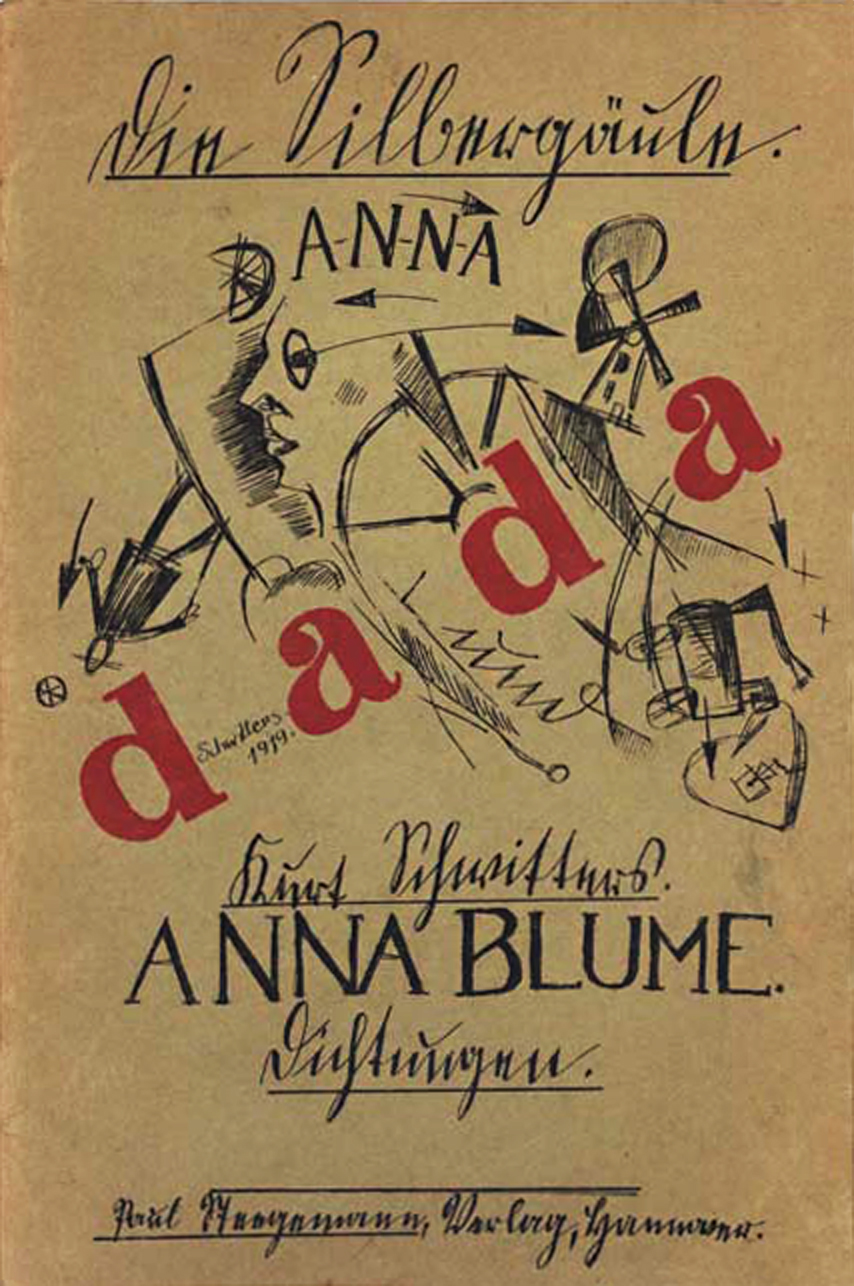 |
| Dadaism poster |
- Nihilism- deliberately embraces nothing
- French for- "hobbyhorse"
- symbolizes emphasis on the illogical and the absurd
- Archetypal forms: nonsense poem and the ready-made
- Creative techniques of accident and chance were sustained in Surrealism, Abstract Expressionism, Conceptual, Art and Pop Art (Andy Warhol)
Tristan Tzara
(Later: Peter Handkey- "Offending the Audience")
collage pastiche
montage assemblage
art by chance, rather than design (i.e., shaking words out of a bag & making something new)
-choreography, poem
FUTURISM (Italy, 1909)
-loved speed, noise, machines, pollution, and cities
2 rival Isms: how do we react?
- Futurists- this is going to save humanity
- Expressionists- all technology is killing humanity
Concrete Poetry- write poem but also make a usual piece out of it (poem in a shape)
Everything would be in one compound
-Antonio Sant'Elia, 1914: La Citta Nuova
Kinetic Sculpture: static but appears to be moving OR actually does move (i.e. a mobile)
 |
| Kinetic Sculpture (mobile) |
"Luce" (play), etc., as commentary on change (plays are too long)
Ended after World War I
3/7/13- Naturalism & Non-realism
(Vimeo: "Meyerhold, Theatre, and the Russian Avant-Garde")
Lots of varying styles aesthetics in late 1800s
Naturalism (continued)
- Harley Granville Barker
- Midsummer design in Savoy, 1914
- not realistic; draping fabric
- Everyman- famous morality play from Medieval times
- Poel as God in Everyman
- Beerbohm Tree's Midsummer
- Realistic; famous for live rabbits
- Alfred Jarry- Ubu Roi
- very controversial play
- originally created to be crazy puppet version of Macbeth
- Theatre l'Oeuvre (Theatre of the Work)
- Benjamin Franklin Wedekind
- scenes of realism then sudden expressionistic scenes
- Pic: University of Waterloo's "Spring Awakening"
- Wedekind's "Lulu"
 |
| University of Waterloo's Spring Awakening |
- Max Reinhardt
- spectacles
- outdoor extravaganza
- Everyman, Midsummer, The Miracle
- would transform Broadway theatres
- Master of Regiebuch
- or, the Promptbook
- wrote down everything he did
- Meyerhold- a great Russian director
- split in Russian theatre between Stanislovski and Meyerhold
- arrested and "purged" in 1920s
- "The Dawns", 1920
- style of acting: Biomechanics
- physical shape and movement; kinetic approach
- constructivism - like arts and crafts projects (looked like machines)
- "The Magnificent Cuckoo"
- like an Erector set
 |
| Meyerhold |
~~~~~~~~~~~~~~~~~~~~~~~~~~~~~~~~~~~~~~~~~~~~~~~~~~~~~~~
Non-Realistic Designers
(beginnings of modern theatre design)
scenography- everything of design work is under 1 person
- Adolphe Appia
- "Parcifal"
- think of space as environment; lighting creates its own language- a kinetic environment and special rhythm
- "Tristan and Isolde", 1896
- "rhythmic spaces"
- Gordon Craig
- Book: "The Art of the Theatre"
- Macbeth, "Scene", Hamlet
- Abstract design
- Ubermarionettes
- also, could use a monochromatic surface for projecting images or shadows
- Robert Edmund Jones, 1887-1954
- "The Dramatic Imagination"
- Macbeth
- Father of American Design
- revolution against realism in scenic design
Ghost Shows: Fantasmagoria & Fantascopes
-create ghosts with projectors
3/5/13- Naturalism
Technology: Late 1800's
"Tromp l'oiel": triumph of the eye (Painting Effects)
The Whip- melodrama with incredible scenery
-Cirque mentality for this time period
Naturalism
"Tromp l'oiel": triumph of the eye (Painting Effects)
 |
| Modern example of Tromp l'oiel |
-Cirque mentality for this time period
Naturalism
- "slice of life"- depicting life onstage
- "fourth wall" realism
- photorealism
Theatre Antoine
- Toulouse-Lautre, illustrator
- visual artists/famous painters involved in theatre
- part of Independent Theatre Movement
- Antoine's staging of Zola's La Terre (1900)
 |
| The Theatre Antoine, today |
Subscription Theatre
- financial loophole- buy subscription to theatre
- Gerhardt Hauptmann
- wrote The Weavers- focused on poverty
- provide capital in advance; like start-up money
- August Strindberg- realistic and nonrealistic plays (Ghost Sonata)
 |
| Ghost Sonata |
- "Pelican"- expressionistic makeup design
- Arthur Schnitzler- La Ronde
- 10 scenes- Men and Women shuffling characters (5men, 5women)
- like: David Hare's The Blue Room
- David Belasco's The Return of Peter Grimm (1907)
(insert: Bohemian Rhapsody instrumental performance)
Independent Theatre Movement
- If main theatres won't put on plays you want to put on, create an independent theatre company
- La Theatre Libre
- artistic programs- it is in itself a work or art
- Toulouse Lautrec
- Theatre du Grand Guignol: Blood, Guts & Nudity
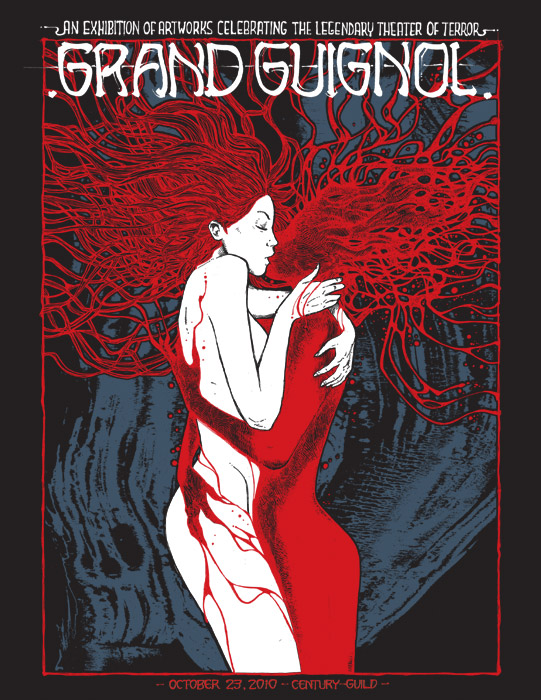 |
| Poster for Theatre du Grand Guignol |
- Vieux Columbier
Early Departures of Realism
Symbolism: Stephane Mallarme
Maurice Maeterlinck
- Les Aveugles- raked painter's palette
Oscar Wilde: Art-for-Art's-Sake ("Aestheticism")
- because it's fun/witty and it relies on wit and humor
- wordplay / wordsmithery
- aristocratic background
- open homosexuality
- original Earnest: 1895
- not uncommon to leave theatre at midnight or later
- (video: Earnest on Broadway trailer)
J.M. Barrie and Peter Pan
- escapist entertainment
- Finkelstein's design for Peter Pan (it's amazing**)
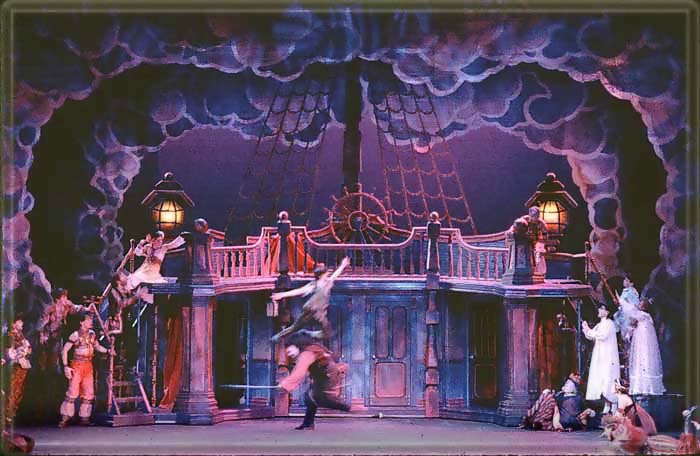 |
| Finkelstein's design for Peter Pan (it's still amazing) |
George Bernard Shaw
- History of Criticism: Father of the Modern Critic
- distaste for Shakespeare
- Shaw's "Man and Superman"
- Most popular: Arms and the Man
Gilbert and Sullivan: Operettas
- shorter, livelier, comic operas
- Patience- makes fun of the Aestheticism movement
- Mikado
- Pirates of Penzance
- Patter Song, like a chase in a melodrama (Modern Major General video)
2/21/13- Realism
Moving Panoramas
-Panorama: Greek for "to see all"
-2 hours; led to cinema
-required 2 technicians to operate/crank
Famous Realistic Actors & Roles:
Sarah Bernhardt, Mary Anderson, Lawrence Bassett, Edwin Booth, Charlotte Cushman, Elenora Dust, Edwin Forrest, Helena Modjeska, James O'Neill, Methua Scheller, Harley Granuille Barker, Maurice Barrymore, Henry Irving
The Beginning of Naturalism
-Emile Zola: wrote novels & plays; box set- real-life situations
-David Belasco: food from restaurant across the theatre
-Constantin Stanislovski:
-Panorama: Greek for "to see all"
-2 hours; led to cinema
-required 2 technicians to operate/crank
 |
| Moving Panoramas |
Famous Realistic Actors & Roles:
Sarah Bernhardt, Mary Anderson, Lawrence Bassett, Edwin Booth, Charlotte Cushman, Elenora Dust, Edwin Forrest, Helena Modjeska, James O'Neill, Methua Scheller, Harley Granuille Barker, Maurice Barrymore, Henry Irving
The Beginning of Naturalism
-Emile Zola: wrote novels & plays; box set- real-life situations
-David Belasco: food from restaurant across the theatre
-Constantin Stanislovski:
- The Father of Modern Acting
- Method Actor
- Objective-based realism
- Why are you doing what you are doing?
 |
| Stanislavski |
NYC Slideshow
"The Great White Way"- 1885, 1903
NYC Theatre: Lyceum
Railroad, Mass Transit, Interstate
Union Square Theatre: Vaudeville Center
"Combination" Company: making money is all that matters
Subway opened in 1904
"The Magic IF"...... What would I do??
Goethe Institute's website..... Designer's pictures~~~ Great inspiration!!
Monday, February 18, 2013
Unit 1- Final Thoughts
As this unit draws to a close, I can definitely begin to see the shape of the “modern theatre”, as we would call it, begin to form before our very eyes. Both the nature and philosophy of theatre were beginning to change along with the eras and each era’s boom in technology. Gas tables became electric lighting boards... Romantic plays became Melodramas.... the American Musical Theatre was just beginning to come into its own form of theatre. Audiences and playwrights alike were shifting from proper plays structured by rules and Unities towards Idealistic plays that presented what life should be like. Paradigms continuously shifted over a very brief window in human history. The journey from Neoclassicism to Realism was brief but furious, as both theatre and theatre’s philosophy were challenged and reinvented.
I, for one, did not really know of Richard Wagner before last week, and now I know him to be of the utmost importance when it comes to the history of theatre. Wagner was basically the man who arranged for “modern theatre” to happen. His tendencies and traditions were passed from him onto the rest of the theatre world, and many of his beliefs are still in use to this day. One of the major forms of Modern Theatre that he gave us was that of “gesamtkunstwerk”, or “master art work”. This is the idea of the unified production, in which all production elements must be integrated into an organic whole. Before this point in time, the many elements of a production weren’t as cohesive as we may have believed them to be, and Wagner gave us the philosophy that would further solidify all the parts of theatre into one unified show. Even his tradition of completely darkening the house during performances was adopted by almost every theatre company today. I had just assumed this was always the tradition of theatre without ever questioning its source. As with many lessons on the history of theatre, it is always rewarding to learn where a certain aspect comes from, and this tradition is no different.
The final part of Unit 1 saw a definitive swing into full-on Realism with several authors to help usher it in to a new era. Henrik Ibsen, Anton Chekhov, and August Strindberg are just a few of the masters who influenced this new style, with Ibsen being declared the “Father of Realism”. With the form of Realism came another paradigmatic shift: showing life as it is, instead of how people thought it should be. These realistic plays would always include a “problem” in them, while remaining completely objective. Everything, down to the scenery and a character’s own psychology, had to be completely authentic and believable.
As the First Unit draws to a close, I can understand the evolution of the theatre more easily. It’s traditions and foundations are clearer and therefore make more sense to me, the more I learn about it. I can’t wait to learn more about the era of Realism and whatever lies beyond it.
Sunday, February 17, 2013
2/14/13- The Realistics
Henrik Ibsen- "Father of Realism" (1828-1906) (Norwegian)
Plays: Hedda Gabler, A Doll's House, Ghosts, Enemy of the People
-all of his realistic plays have social problems
BOX SET-
Fourth Wall- like from the picture frames
EX. The Big Bang Theory (and other multi-camera sitcoms)
JOG- breaking up the box set for interest
Fragmentary Realism- just enough set to let you know location/the feeling
Ex. No walls used
Anton Chekhov (1860-1904) (Russian surgeon)
Plays: The Seagull, Uncle Vanya, The Cherry Orchard, Three Sisters
 |
| Henrik Ibsen |
-all of his realistic plays have social problems
BOX SET-
Fourth Wall- like from the picture frames
EX. The Big Bang Theory (and other multi-camera sitcoms)
JOG- breaking up the box set for interest
Fragmentary Realism- just enough set to let you know location/the feeling
Ex. No walls used
Digital Theatre's "A Doll's House" Trailer:
available at www.digitaltheatre.com
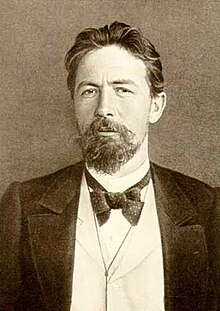 |
| Anton Chekhov |
August Strindberg (1849-1912) (Swedish)
~~~~~~~~~~~~~~~~~~~~~~~~~~~~~~~~~~~~~~~~~~~~~~~~~~~~~~~~~~~~~~~~~~~~~~~~
2/12/13- 19th Century Theatre
Other Trends in 19th Century Theatre
-with realism, the development of box sets and fourth wall conventions
Richard Wagner
 |
| Wagner |
- complete illusionism (theatre as mythmaking)
- first to completely darken the House (1860's)
- "democratic" seating arrangement at Bayreuth
- every seat is equally good
- all production elements must be integrated into an organic whole or a "master art work"
- "gesamtkunstwerk" (unified production~ sign of modern theatre)
- emphasis on historical accuracy
- no applause or curtain call (they ruin the illusion!)
- built his own radical theatre based on sightlines of the audience (Bayreuth)
- Orchestra Pit:
- curved shell for sound amplification back to the stage
- no visibility between audience and anything/anybody in the pit
- Teutonic Myths
- Wagner loved Old German myths & making operas out of them
A taste of the Met's recent production of Wagner's The Ring Cycle:
check more out at www.pbs.com
Georg II, Duke of the Saxe-Meiningen
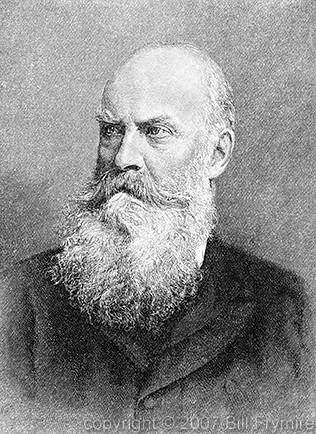 |
| Georg II |
- had a ducal theatre (court theatre)
- director AND artistic director
- don't bring actors in until everything else is already completed & ready
- possibly one of the first to consider "of Note"
Dumas & "Camille" Controversy:
- main character: prostitute with heart of gold
- sympathetic portrayal of sinful person
- First Camille: Sarah Bernhardt (1881)
- most famous actress in Europe (think: Mega Meryl Streep)
 |
| Sarah Bernhardt |
REALISM (another paradigmatic shift)
- show life as it is: "problem" plays
- objective reality: life as actually experienced
- no moral judgment; not idealistic
- ending is rarely happy
- characters are psychologically believable
- neither good nor bad (they're just people)
- scenery is often very authentic= "photorealism"
- scenery exploits technology for realism
~~~~~~~~~~~~~~~~~~~~~~~~~~~~~~~~~~~~~~~~~~~~~~~~~~
Subscribe to:
Posts (Atom)

